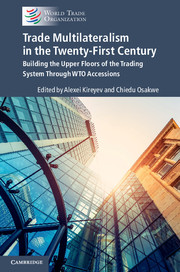 Trade Multilateralism in the Twenty-First Century
Trade Multilateralism in the Twenty-First Century Book contents
- Frontmatter
- Contents
- List of Plates
- List of Figures
- Notes on Contributors
- Foreword
- Acknowledgements
- List of Abbreviations
- Disclaimer
- 1 Making Trade Multilateralism Work for All: The Role of WTO Accessions
- PART I WTO Accessions and the New Trade Multilateralism
- PART II Negotiators’ Perspectives on the WTO Accession Process
- PART III Accessions Acquis: Thematic Perspectives and Implementation Challenges
- 13 How Post-TRIPS Negotiations Reframe the ‘Trade-Related Aspects’ of Intellectual Property after TRIPS: The Lessons of WTO Accessions
- 14 Competition Policy in WTO Accessions: Filling in the Blanks in the International Trading System
- 15 Geographical Indications in the Accessions Landscape
- 16 WTO Accession Commitments on Agriculture: Lessons for WTO Rule-Making
- 17 The WTO-Plus Obligations: Dual Class or a Strengthened System?
- 18 Accession Protocols and the Private Sector
- 19 Post-Accession Support Platform
- 20 Conclusion: Trade Multilateralism - Enhancing Flexibility, Preserving the Momentum
- Contributor Biographies
- Index
- References
16 - WTO Accession Commitments on Agriculture: Lessons for WTO Rule-Making
from PART III - Accessions Acquis: Thematic Perspectives and Implementation Challenges
Published online by Cambridge University Press: 28 November 2017
- Frontmatter
- Contents
- List of Plates
- List of Figures
- Notes on Contributors
- Foreword
- Acknowledgements
- List of Abbreviations
- Disclaimer
- 1 Making Trade Multilateralism Work for All: The Role of WTO Accessions
- PART I WTO Accessions and the New Trade Multilateralism
- PART II Negotiators’ Perspectives on the WTO Accession Process
- PART III Accessions Acquis: Thematic Perspectives and Implementation Challenges
- 13 How Post-TRIPS Negotiations Reframe the ‘Trade-Related Aspects’ of Intellectual Property after TRIPS: The Lessons of WTO Accessions
- 14 Competition Policy in WTO Accessions: Filling in the Blanks in the International Trading System
- 15 Geographical Indications in the Accessions Landscape
- 16 WTO Accession Commitments on Agriculture: Lessons for WTO Rule-Making
- 17 The WTO-Plus Obligations: Dual Class or a Strengthened System?
- 18 Accession Protocols and the Private Sector
- 19 Post-Accession Support Platform
- 20 Conclusion: Trade Multilateralism - Enhancing Flexibility, Preserving the Momentum
- Contributor Biographies
- Index
- References
Summary
Abstract
This chapter explains how accession negotiations have helped to further the agricultural reform process by upgrading and deepening the existing multilateral rules on trade in agriculture. It provides a broad overview of the existing multilateral disciplines in the area of agriculture, as contained in the Agreement on Agriculture (AoA). Using the experience of the thirty-six concluded accessions, the chapter suggests that a number of commitments, such as extensive market access commitments, ambitious domestic support commitments and comprehensive bindings with regard to export duties, helped establish high benchmarks vis-à-vis the undertakings of the original members of the World Trade Organization (WTO). In market access, the commitments of acceded members are primarily in the form of reductions in tariff bindings, with a very limited use of tariff rate quotas. In domestic support, the commitments of the acceded members have been negotiated based on the respective recourse to such support during a recent three-year period, dependent on the timing of the individual accessions. These commitments are generally more ambitious than the corresponding commitments of the original members under the AoA, which were derived based on the domestic support policy framework existing in 1986–8. Similarly, in the field of export subsidies, the acceded governments’ ambitious efforts to eliminate these highly distorting subsidies helped to create a strong momentum in the broader agriculture negotiations, leading to the eventual agreement on the global elimination of agricultural export subsidies at the Nairobi Ministerial Conference in 2015.
Acceding governments negotiate their accession terms by way of engaging in negotiations with WTO members within the framework of Article XII of the Marrakesh Agreement Establishing the World Trade Organization (WTO Agreement). The outcome of the negotiations is included in an instrument referred to as the accession protocol that in turn is integrated into the WTO Agreement. In order to understand the negotiating process, it may be useful to keep in mind the final objective, i.e. to determine the scope and contours of the WTO Agreement that the acceding government will accept to abide by upon successful conclusion of the negotiations and the consequent assumption of WTO membership.
The WTO Agreement may be divided broadly into two parts: the global, rules-based undertakings that all members have to comply with, and the member-specific commitments in the schedule, which are binding on the member concerned.
- Type
- Chapter
- Information
- Trade Multilateralism in the Twenty-First CenturyBuilding the Upper Floors of the Trading System through WTO Accessions, pp. 339 - 356Publisher: Cambridge University PressPrint publication year: 2017
